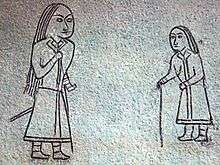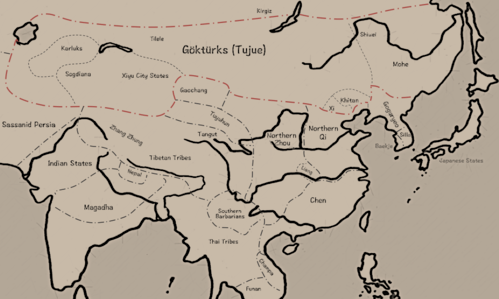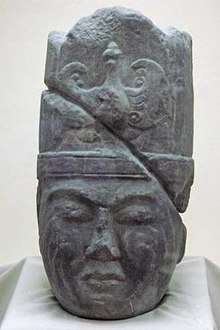Göktürks
 Göktürk petroglyphs from Mongolia (6th to 8th century) | |
| Total population | |
|---|---|
| Ancestral to Turkic population | |
| Regions with significant populations | |
| Central Asia | |
| Languages | |
| Old Turkic | |
| Religion | |
| Tengrism |
The Göktürks, Celestial Turks, Blue Turks , Kok Turks or Götürk (Old Turkic: 𐰜𐰇𐰛:𐱅𐰇𐰼𐰰, Kök Türük; Chinese: 突厥/تُركِئ; pinyin: Tūjué, Middle Chinese: *duət̚-kʉɐt̚ (türkut), Dungan: Тўҗүә; Khotanese Saka: Ttūrka, Ttrūka;[1] Old Tibetan: Drugu[1]), were a nomadic confederation of Turkic peoples in medieval Inner Asia. The Göktürks, under the leadership of Bumin Qaghan (d. 552) and his sons, succeeded the Rouran Khaganate as the main power in the region and established the Turkic Khaganate, one of several nomadic dynasties which would shape the future geolocation, culture, and dominant beliefs of Turkic peoples.
Etymology


Strictly speaking, the common name Göktürk is the Anatolian Turkish form of the ethnonym. The Old Turkic name for the Göktürks was 𐱅𐰇𐰼𐰰 Türük,[2][3] 𐱅𐰇𐰼𐰰:𐰜𐰇𐰛 Kök Türük,[2][3] or ![]()
![]()
![]()
![]()
Göktürk means "Celestial Turks",[8] or sometimes "Blue Turks" (i.e. because sky blue is associated with celestial realms). This is consistent with "the cult of heavenly ordained rule" which was a recurrent element of Altaic political culture and as such may have been imbibed by the Göktürks from their predecessors in Mongolia.[9] The name of the ruling Ashina clan may derive from the Khotanese Saka term for "deep blue", āššɪna.[10]
The word Türk meant "strong" in Old Turkic.[11]
Origins
The Göktürk rulers originated from the Ashina clan, who were first attested to 439. The Book of Sui reports that in that year, on October 18, the Tuoba ruler Emperor Taiwu of Northern Wei overthrew Juqu Mujian of the Northern Liang in eastern Gansu,[12][13][14] whence 500 Ashina families fled northwest to the Rouran Khaganate in the vicinity of Gaochang.[6][15] Peter Benjamin Golden points out that the khaghans of the Turkic Khaganate, the Ashina, who were of an undetermined ethnic origin, adopted Iranian and Tokharian titles.[16] German Turkologist W.-E. Scharlipp points out that many common terms in Turkic are Iranian in origin.[17]
According to the Book of Zhou and the History of the Northern Dynasties, the Ashina clan was a component of the Xiongnu confederation,[5][7] but this connection is disputed,[18] and according to the Book of Sui and the Tongdian, they were "mixed Hu (barbarians)" (雜胡) from Pingliang.[6][19] Indeed, Chinese sources linked the Hu on their northern borders to the Xiongnu just as Graeco-Roman historiographers called the Pannonian Avars, Huns and Hungarians "Scythians". Such archaizing was a common literary topos, and implied similar geographic origins and nomadic lifestyle but not direct filiation.[20]
As part of the heterogeneous Rouran Khaganate, the Türks lived for generations north of the Altai Mountains, where they 'engaged in metal working for the Rouran'.[6][21] According to Denis Sinor, the rise to power of the Ashina clan represented an 'internal revolution' in the Rouran Khaganate rather than an external conquest.[22] According to Charles Holcombe, the early Tujue population was rather heterogeneous and many of the names of Türk rulers, including the two founding members, are not even Turkic.[23] This is supported by evidence from the Orkhon inscriptions, which include several non-Turkic lexemes, possibly representing Finno-Ugric or Samoyedic words.[24]
Expansion
Göktürk reached its peak in late 6th century and began to invade Sui Dynasty of China. However, the war ended due to the division of Turkish nobles and their civil war for the throne of Khagan. With the support of Emperor Wen of Sui, Jami Qayan won the competition. However, the Göktürk empire was divided to Eastern and Western empires. Weakened by the civil war, Jami Qayan declared allegiance to Sui Dynasty. [25] When Sui began to decline, Shibi Khah began to assault its territory and even surrounded Emperor Yang of Sui in Siege of Yanmen (615 AD) with 100000 cavalry troops. After the collapse of China's Sui dynasty, the Göktürks intervened in the ensuing civil wars, providing support to the northeastern rebel Liu Heita against the rising Tang in 622 and 623. He enjoyed a long string of success but was finally routed by Li Shimin and other Tang generals and executed.
Fall and Restoration
Although Göktürk Khaganate once provided support to the Tang Dynasty in the early period of Chinese civil war, the conflicts between Göktürk and Tang finally broke out when Tang was gradually reuniting China. Göktürk began to attack and raid the northern border of Tang Empire and once marched their main force to Chang'an, the capital of Tang. Having not been recovered from the civil war, Tang Empire had to pay tribute to Göktürk nobles. [26] Allied with tribes against Göktürk Khaganate,Tang Empire defeated the main force of Göktürk army in Battle of Yinshan 4 years later and captured Illig Qaghan in 630 AD. [27] With the submission of Turk tribes, Tang conquered Mongolia Plateau.
After hard court debate, Emperor Taizong decided to pardon the Göktürk Nobles and offered them the positions of imperial guards.[26] However, the plan ended in an assassination of the emperor. On May 19, 639[28] Ashina Jiesheshuai and his tribesmen directly assaulted Emperor Taizong of Tang at Jiucheng Palace (九成宮, in present-day Linyou County, Baoji, Shaanxi). However, they did not succeed and fled to the north, but were caught by pursuers near the Wei River and were killed. Ashina Hexiangu was exiled to Lingbiao.[29] After the unsuccessful raid of Ashina Jiesheshuai, on August 13, 639[30] Taizong installed Qilibi Khan and ordered the settled Turkic people to follow him north of the Yellow River to settle between the Great Wall of China and the Gobi Desert.[31]However, many Göktürk generals still remain loyal service in Tang Empire.
In 679, Ashide Wenfu and Ashide Fengzhi, who were Turkic leaders of the Chanyu Protectorate (單于大都護府), declared Ashina Nishufu as qaghan and revolted against the Tang dynasty.[32] In 680, Pei Xingjian defeated Ashina Nishufu and his army. Ashina Nishufu was killed by his men.[32] Ashide Wenfu made Ashina Funian a qaghan and again revolted against the Tang dynasty.[32] Ashide Wenfu and Ashina Funian surrendered to Pei Xingjian. On December 5, 681[33] 54 Göktürks including Ashide Wenfu and Ashina Funian were publicly executed in the Eastern Market of Chang'an.[32] In 682, Ilterish Qaghan and Tonyukuk revolted and occupied Heisha Castle (northwest of present-day Hohhot, Inner Mongolia) with the remnants of Ashina Funian's men.[34]The restored Göktürk Khaganate intervened in the war between Tang and Khitan tribes. [35] However, after the death of Bilge Qaghan, Göktürk could no longer subjugate other turk tribes in grassland. In 744, allied with Tang Dynasty, Uyghur Khaganate defeated the last Göktürk Khaganate and controlled Mongolia Plateau.[36]
Rulers
See also
| Wikimedia Commons has media related to Göktürks. |
References
- 1 2 3 Golden 2011, p. 20.
- 1 2 Kultegin's Memorial Complex, Türik Bitig Orkhon inscriptions
- 1 2 Bilge Kagan's Memorial Complex, Türik Bitig
- ↑ Tonyukuk's Memorial Complex, Türik Bitig Bain Tsokto inscriptions
- 1 2 Linghu Defen et al., Book of Zhou, Vol. 50. (in Chinese)
- 1 2 3 4 Wei Zheng et al., Book of Sui, Vol. 84. (in Chinese)
- 1 2 Li Yanshou (李延寿), History of the Northern Dynasties, Vol. 99. (in Chinese)
- ↑ Marshall Cavendish Corporation 2006, p. 545.
- ↑ Wink 64.
- ↑ Findley 2004, p. 39.
- ↑ American Heritage Dictionary (2000). "The American Heritage Dictionary of the English Language: Fourth Edition - "Turk"". bartleby.com. Archived from the original on 2007-01-16. Retrieved 2006-12-07.
- ↑ Wei Shou, Book of Wei, Vol. 4-I. (in Chinese)
- ↑ Sima Guang, Zizhi Tongjian, Vol. 123. (in Chinese)
- ↑ 永和七年 (太延五年) 九月丙戌 Academia Sinica (in Chinese) Archived 2013-10-16 at the Wayback Machine.
- ↑ Christian, p. 249.
- ↑ Golden 1992, p. 126.
- ↑ „(...) Über die Ethnogenese dieses Stammes ist viel gerätselt worden. Auffallend ist, dass viele zentrale Begriffe iranischen Ursprungs sind. Dies betrifft fast alle Titel (...). Einige Gelehrte wollen auch die Eigenbezeichnung türk auf einen iranischen Ursprung zurückführen und ihn mit dem Wort „Turan“, der persischen Bezeichnung für das Land jeneseits des Oxus, in Verbindung bringen.“ Wolfgang-Ekkehard Scharlipp in Die frühen Türken in Zentralasien, p. 18
- ↑ Christian, p. 249
- ↑ 杜佑, 《通典》, 北京: 中華書局出版, (Du You, Tongdian, Vol.197), 辺防13 北狄4 突厥上, 1988, ISBN 7-101-00258-7, p. 5401. (in Chinese)
- ↑ Sinor 1990.
- ↑ Sima Guang, Zizhi Tongjian, Vol. 159. (in Chinese)
- ↑ Sinor 1990, p. 295.
- ↑ Holcombe 2001, p. 114.
- ↑ Sinor 1990, p. 291.
- ↑ Wei 魏, Zheng 徵 (656). Book of Sui 隋書 Vol. 2 Vol. 51 & Vol.84.
- 1 2 Liu 劉, Xu 昫 (945). Old Book of Tang 舊唐書 Vol.2 & Vol.194.
- ↑ Liu 劉, Xu 昫 (945). Old book of Tang 舊唐書 Vol.2 & Vol. 67.
- ↑ 貞觀十三年 四月戊寅 Academia Sinica Archived 2010-05-22 at the Wayback Machine. (in Chinese)
- ↑ Sima Guang, Zizhi Tongjian, Vol. 195. (in Chinese)
- ↑ 貞觀十三年 七月庚戌 Academia Sinica Archived 2010-05-22 at the Wayback Machine. (in Chinese)
- ↑ Ouyang Xiu et al., New Book of Tang, Vol. 215-I.
- 1 2 3 4 Sima Guang, Zizhi Tongjian, Vol. 202 (in Chinese)
- ↑ 開耀元年 十月乙酉 Academia Sinica Archived 2010-05-22 at the Wayback Machine. (in Chinese)
- ↑ Sima Guang, Zizhi Tongjian, Vol. 203 (in Chinese)
- ↑ Liu 劉, Xu 昫 (945). Old Book of Tang 舊唐書 Vol. 6 & Vol.194.
- ↑ Liu 劉, Xu 昫 (945). Old Book of Tang 舊唐書 Vol.103,Vol.194 & Vol.195.
Sources
- Christian, David. A history of Russia, Central Asia and Mongolia, Vol. 1: Inner Eurasia from prehistory to the Mongol Empire. Blackwell, 1998.
- Findley, Carter Vaughn (2004). The Turks in World History. Oxford University Press. ISBN 978-0-19-988425-4.
- Golden, Peter B. (1992). An Introduction to the History of the Turkic Peoples. O. Harrassowitz.
- Golden, Peter Benjamin (2011). "Ethnogenesis in the tribal zone: The Shaping of the Turks". Studies on the peoples and cultures of the Eurasian steppes. Bucureşti: Ed. Acad. Române. ISBN 978-973-1871-96-7.
- Great Soviet Encyclopaedia, 3rd ed. Article "Turkic Khaganate" (online).
- Grousset, René. The Empire of the Steppes. Rutgers University Press, 1970. ISBN 0-8135-1304-9.
- Gumilev, Lev (2007) (in Russian) The Göktürks (Древние тюрки ;Drevnie ti︠u︡rki). Moscow: AST, 2007. ISBN 5-17-024793-1.
- Skaff, Jonathan Karem (2009). Nicola Di Cosmo, ed. Military Culture in Imperial China. Harvard University Press. ISBN 978-0-674-03109-8.
- Yu. Zuev (I︠U︡. A. Zuev) (2002) (in Russian), "Early Türks: Essays on history and ideology" (Rannie ti︠u︡rki: ocherki istorii i ideologii), Almaty, Daik-Press, p. 233, ISBN 9985-4-4152-9
- Wechsler, Howard J. (1979). "T'ai-Tsung (Reign 626-49): The Consolidator". In Denis Twitchett; John Fairbank. The Cambridge History of China, Volume 3: Sui and T'ang China Part I. Cambridge University Press. ISBN 978-0-521-21446-9.
- Wink, André. Al-Hind: The Making of the Indo-Islamic World. Brill Academic Publishers, 2002. ISBN 0-391-04173-8.
- Zhu, Xueyuan (朱学渊) (2004) (in Chinese) The Origins of the Ethnic Groups of Northern China (中国北方诸族的源流). Beijing: Zhonghua Shuju (中华书局) ISBN 7-101-03336-9
- Xue, Zongzheng (薛宗正) (1992) (in Chinese) A History of the Turks (突厥史). Beijing: Chinese Social Sciences Press (中国社会科学出版社) ISBN 7-5004-0432-8
- Nechaeva, Ekaterina (2011). "The "Runaway" Avars and Late Antique Diplomacy". In Ralph W. Mathisen, Danuta Shanzer. Romans, Barbarians, and the Transformation of the Roman World: Cultural Interaction and the Creation of Identity in Late Antiquity. Ashgate. pp. 175–181. ISBN 9780754668145.
- Sinor, Denis (1990). The Cambridge History of Early Inner Asia. Cambridge University Press. ISBN 978-0-521-24304-9.
